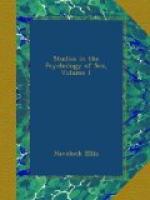We may thus, perhaps, understand why it is that hysteria and anaemia are often combined, and why they are both most frequently found in adolescent young women who have yet had no sexual experiences. Chlorosis is a physical phenomenon; hysteria, largely a psychic phenomenon; yet, both alike may, to some extent at least, be regarded as sexual aptitude showing itself in extreme and pathological forms.
FOOTNOTES:
[251] Genese et Nature de l’Hysterie, 1898; and, for Sollier’s latest statement, see “Hysterie et Sommeil,” Archives de Neurologie, May and June, 1907. Lombroso (L’Uomo Delinquente, 1889, vol. ii, p. 329), referring to the diminished metabolism of the hysterical, had already compared them to hibernating animals, while Babinsky states that the hysterical are in a state of subconsciousness, a state, as Metchnikoff remarks (Essais optimistes, p. 270), reminiscent of our prehistoric past.
[252] Professor Freud, while welcoming the introduction of the term “auto-erotism,” remarks that it should not be made to include the whole of hysteria. This I fully admit, and have never questioned. Hysteria is far too large and complex a phenomenon to be classed as entirely a manifestation of auto-erotism, but certain aspects of it are admirable illustrations of auto-erotic transformation.
[253] The hysterical phenomenon of globus hystericus was long afterward attributed to obstruction of respiration by the womb. The interesting case has been recorded by E. Bloch (Wiener Klinische Wochenschrift, 1907, p. 1649) of a lady who had the feeling of a ball rising from her stomach to her throat, and then sinking. This feeling was associated with thoughts of her husband’s rising and falling penis, and was always most liable to occur when she wished for coitus.




